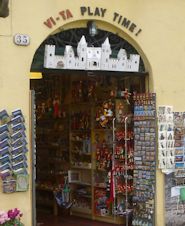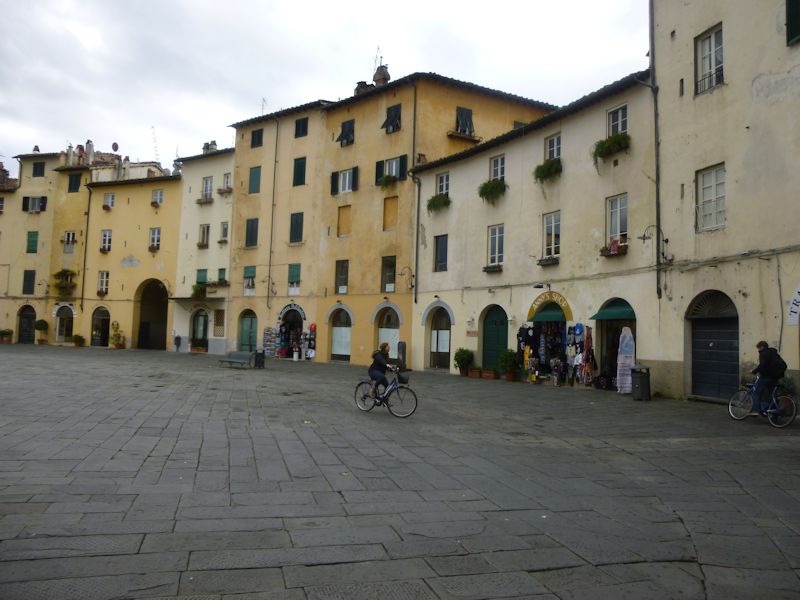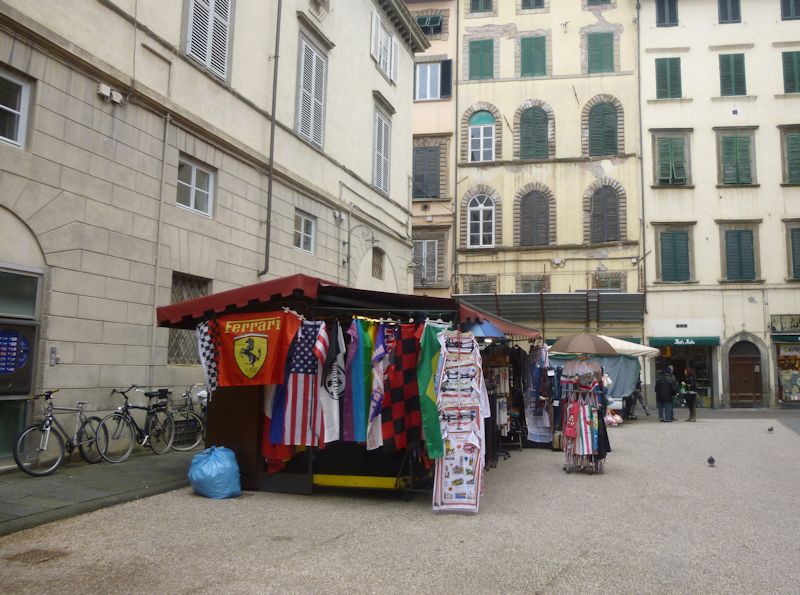|
 Dwight Peck's personal website Dwight Peck's personal website
Two weeks in Piemonte and Tuscany
in northwest Italy's worst weather in yonks
You may not find this terribly rewarding unless you're included here, so this is a good time for casual and random browsers to turn back before they get too caught up in the sweep and majesty of the proceedings and can't let go.
We wanted to visit Lucca and environs, but when we decided to break up the drive with a night spent halfway in each direction, one thing led to another.
But finally, here we are in . . .
Lucca 1: Settling in, the Anfiteatro, the Torre Guinigi, 15 November 2014

Here's our little flat for the next eight days, one of four apartments owned by the B+B Anfiteatro, which itself has got 5 rooms on the Via dell' Anfiteatro, which runs round the outside wall of the Roman amphitheatre, and also offers 4 suites on the nearby Via Fillungo, the main pedestrian thoroughfare through the northern half of this city of 88,000 citizens.

Our flat is called the Busdraghi (two windows above the square central door), and indeed the street is the Via Busdraghi (named for an important Lucchese family from the 12th to the 19th century), leading off the Via Fillungo (at the far end in this photo) and parallel to the Via dell' Anfiteatro.

The salon, overlooking the Via Busdraghi

With all the mod cons

The bedroom, overlooking a small square in the next street

The Squirrel is still jumpy after our ride. With flooding all round Genoa, we've gone via Piacenza and Parma over the mountain road in a fairly unnerving driving rain down to the Tyrrhenian coast at La Spezia.

But jumpy is one thing, now it's time for a nap.

Another view of the salon; it's time for dinner (the great Osteria Baralla, since 1860 operating in a 15th century palace at one of the Anfiteatro gates; we seldom went elsewhere).

The next day, we assemble on the street in front of our flat (in the rain) and set off to explore the city. Lucca, originally a Celtic-Ligurian settlement (the name is said to derive from a Celtic word for "marshy"), was an Etruscan city before the advent of the Romans, who elevated it to colonia status in 180 BC. Caesar, Crassus, and Pompey re-stitched up their fraying Triumvirate here in 56 BC (Goldsworthy, Caesar, chap. xii).

The Via Fillungo begins here near the Porta Santa Maria, one of the six gates into the city through the 16th century city walls that run all the way round it. Via Fillungo curves all the way southward down into the city centre near the former Roman Forum. Generally the city preserves its Roman grid street plan, with medieval streets and alleys stuck in within the grid.

We're passing up on the Museum of Torture. This is apparently a franchise chain, like Starbucks or Mr Minit, as we saw the same establishments, with the same poster iconography, in other cities in the region.

A presently competing hotel in a formerly competing palazzo.

The Basilica of San Frediano: Saint Fred was an Irish monk and bishop of Lucca in the early 500s who built an earlier church on this spot. The church was enlarged over the years, and assumed its present structure in the early 12th century. The Byzantinish golden mosaic atop the façade dates from the 13th century. We'll be back.
The Piazza dell' Anfiteatro

The Via Fillungo curves round the Roman-era amphitheatre, which was outside the original Roman city walls but subsequently lay within the Renaissance defenses.

We'll have a look.

Kristin through the western gate

The interior of the Anfiteatro, where games and gladiatorial combats were staged in Roman times, dates from the later 1st century AD. During the Gothic Wars in the 6th century and the city's siege by the great Byzantine general, the eunuch Narses, the amphitheatre's position outside the walls made it dangerous for the city's safety, and it was subsequently fortified and put to other uses (like, as usual, a prison, as well as vegetable gardens, open markets, and what not).

Over time, an elliptical community had built itself around and within the anfiteatro, as much of the original building materials were carried off for new projects (like the Basilica of San Frediano), but in the 1830s the centre was recreated as a piazza by the demolition of the medieval-plus housing that had grown up within it.

The Piazza dell' Anfiteatro is presently a popular spot for tourist and natives, with bustling shops and festive restaurants all round, most of them taking a November break just now.

And none of the restaurants are staying open in the evenings.

Views of the Anfiteatro. Lucca prospered by way of the silk trade from the 11th century onward. The "Gran Contessa", Matilda of Canossa, Countess of Tuscany, who ruled Tuscany from her capital in Lucca, led armies around in late 11th century battles, winning some, losing some, and was a frequently decisive focal point in the "Investiture" battles between Holy Roman Emperor Henry IV and Pope Gregory VII and subsequent popes. She was leading attacks even in her fifties against Ferrara, Parma, Prato, and Mantova up to the year before her death in 1115.

Following Matilda's death, many northern Italian cities began filling the political vacuum by evolving towards republican and oligarchic forms of communal government, more or less self-governing usually under the overlordship of some feudal family or ambitious city or other (like Florence, Milan, or Venice) or the Papal States. Lucca set up a republican charter in 1160 that lasted for nearly 500 years.

Vi-Ta Play Time! Guelph (pope-sympathizing) and Ghibelline (emperor-sympathizing) families traded ascendancy in Lucca back and forth between them throughout the high Middle Ages, and the city was bought, sold, and pawned as the property of overlords and rich investors into the 17th century.

The Piazza dell' Anfiteatro. Remains of the original Roman walls are still part of the structure and can be seen at various places sticking out of the walls around the Via dell' Anfiteatro . . .

. . . like here.

-- Want a United States flag for your wall? A Ferrari flag?

Yum-yum. Amongst Napoleon's adventures in setting up new liberal governments in Italy, after capturing Lucca in 1799, in 1805 he bestowed his 28-year-old sister Élisa upon the Lucchese population as Princess of Piombino and Lucca, and later Grand Duchess of Tuscany. She organized things very actively and ably by all accounts, even despite serious conflicts with her imperial brother, until she was deposed by the English capture of Lucca under Bentinck in 1814. Duchess Élisa died in 1820 at the age of 43, whilst leading archaeological excavations near Udine.

We've turned east off Via Fillungo along the Via Sant'Andrea, and that seems to be an early Renaissance urban tower with trees growing out of it (reducing the overall heat emissions of the city).

In 1847, the independent commune of Lucca was absorbed into Tuscany and thence into the Kingdom of Italy in 1861. Why are trees growing out of that urban tower?
Trees indeed, and oak trees, unless my eyes deceive me.

But first a stop-off in the Piazza del Carmine, to see this tower, this old covered market, and, most importantly, the SPAR market behind me, three blocks from our flat, with a generous selection of beers and wines, and things that Kristin likes, like olives, weird cheeses, and prosciutto. We'll be back.
The Torre Guinigi

Like all Italian cities, Lucca had always been juggled about by a small number of ruling families, amongst which were the merchant Guinigi clan. In particular, Paolo Guinigi came forward to rule Lucca as 'Captain and Defender of the People' in 1400 and ran the place evidently quite wisely until he was overthrown in 1430.

"Don't think . . ." The face appears all over the city with clever if somewhat subversive messages.

'How Lucca came to have twelve banners' -- one of the many medievalish historical testimonials ornamenting the long climb up the Torre Guinigi.

By the 14th century, the powerful Guinigi family of silk merchants had built a complex of palaces and towers in this neighborhood in the eastern portion of the old city; of the family's four towers dominating the intersection of the Via Guinigi and Via Sant'Andrea, only this one was left when most of the more than 200 privately owned defensive towers in the city were destroyed or drastically shortened in the 16th century.

The presence of a garden of trees on top of the tower is attested from images from the 16th century.

The Cathedral of St Martin, the Duomo di Lucca

Looking northwest

Scenes from the tower

The Duomo to the south-southwest

Looking northward from the Guinigi tower at the San Frediano basilica and, beyond the trees on the city wall, our car Dietrich VW in the free municipal carpark. Where some miscreant stole our left wing mirror. But one of the B+B's staff members' dad was able replace it cheaply at his carrozzeria out in Quiesa the same day.

Looking due west from the tower at San Michele in Foro and the Civic Clocktower

San Frediano (centre-left) and the elliptical Anfiteatro (centre to the right margin)

The Chiesa di Santa Maria Bianca, or Santa Maria Forisportam ('St Mary outside the gate'), south of the Guinigi Tower

Down we go . . .

. . . 38 metres down, in fact

The original Guinigi/Sant'Andrea intersection, heart of the Guinigi family's neighborhood, or 'turf'

Just down the street, here is the Chiesa di Santa Maria Forisportam ('St Mary outside the gate', the Roman gate, that is), also called Santa Maria Bianca, built in the late 1100s along one of the oldest east-west through streets, the Via Santa Croce. In what's called the "Pisan-Romanesque style', the row of blind arcades on the façade are interesting.

Tonight, a 'Gala Lirico' up the street -- actually an operatic recital called "The Australians in Lucca 2014" (most of them young Australian opera singers working in Italy), in a beautiful renovated oratory in Guardian Angel Street (Via Angeli Custodi); it was inexpensive and very good indeed, ending with a few modern Australian favorites that brought the crowd to its feet. A largely Australian crowd.

We're walking east along the Via Santa Croce towards the Porta San Gervasio, one of the city gates of the 1260 city wall just inside the 'fosse' or moat.

We were looking for the Cathedral and fetched up here, back at the Santa Maria Bianca. We'll try harder next time.

The red dot shows our little flat near the Anfiteatro.
       
     



 Feedback
and suggestions are welcome if positive, resented if negative, Feedback
and suggestions are welcome if positive, resented if negative,  .
All rights reserved, all wrongs avenged. Posted 6 December 2014. .
All rights reserved, all wrongs avenged. Posted 6 December 2014.
|
 Dwight Peck's personal website
Dwight Peck's personal website

































































